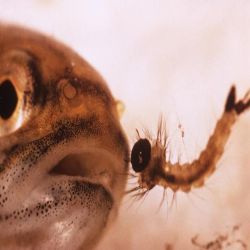The Cayman Islands Mosquito Research & Control Unit
Our mosquito control program employs the principles of Integrated Pest Management by first determining the species and abundance of mosquitoes through larval and adult surveillance and then using the most efficient, effective and environmentally sensitive means of control.
Integrated Pest Management

In order to accomplish long-range, intelligent, and environmentally sound mosquito control, the management of mosquitoes must use not just one but all available pest control methods. This dynamic combination of methods into one thoughtful, ecologically-sensitive program is referred to as Integrated Pest Management (IPM). Sometimes when referring to vector mosquitoes, this program is referred to as Integrated Vector Management (IVM). MRCu’s mosquito control program employs IPM principles by first determining the species and abundance of mosquitoes through larval and adult surveillance and then using the most efficient, effective and environmentally sensitive means of control. In some situations, water management or source reduction programs can be instituted to reduce breeding areas. MRCU also considers biological control such as the planting of mosquitofish (Gambusia affinis). When these approaches are not practical or otherwise appropriate, then a pesticide program is used so that specific breeding areas and/or adult mosquitoes can be treated.
The Cayman Islands has many water sources that act as mosquito/vector breeding areas near populated areas. Without ongoing and effective mosquito control, the human environment would be significantly and adversely affected by substantial mosquito activity. MRCU’s mosquito control program, including biological and chemical control, is essential to abate the vectors in the environment to a tolerable level. MRCU’s program will never alleviate all mosquito vectors. Rather, it is a maintenance program aimed at striking a balance to allow comfortable and healthful human existence, while protecting and maintaining the environment. History has shown us that the control and abatement of vectors are necessary for our human environment to continue to be habitable.
MRCU’s mosquito control program is directed primarily at the larval stages of mosquitoes. Control activities are contained to a localized area and have a lower impact utilizing this approach because the larvicides used by MRCU specifically target the mosquito’s biological systems. Although adult mosquitoes may be targeted for control, it is not the emphasis of MRCU’s program. Focusing on mosquito larvae requires that control be achieved in a number of different types of breeding sources.
Monitoring & Surveillance
Surveillance is a blanket term for monitoring mosquito populations over time in an integrated mosquito management program. It is the key to understanding local species mix, breeding habitats, population levels, and the potential for arbovirus disease cycles. MRCU has a range and traps and other tools available for adult and larval mosquito surveillance.

The New Jersey Light Trap
The New Jersey Light Trap was the very first trap type used to monitor male and female adult mosquito populations, with origins dating back to the 1930s. MRCU has an established network of 30+ New Jersey traps distributed across all three islands. This network has been in place since the 1960’s when MRCU was first founded. The New Jersey Light Trap uses a basic light bulb to attract mosquitoes and a motorized fan to draw mosquitoes into the trap itself. This trap is primarily used to measure the overall abundance of mosquito populations and establish historical population trends.
Advantages of the New Jersey Light Trap:
- Attracts multiple mosquito species
- Proven and effective
- Stationary device, one-time set-up (per season)
- Affordable
Drawbacks of the New Jersey light trap:
- Light bulb attractant competes with other light sources near trap location
- Attracts many insects, not just mosquitoes
- Requires electricity access
- Motorized fan or other collected insects damage specimens entering the trap, making species identification challenging
- Time-consuming for technicians to “rough sort” mosquitoes from other insects collected in the trap
- Heavy, cumbersome equipment is time-intensive to install and remove
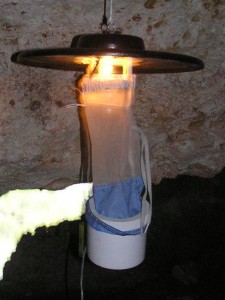
The CDC Light Trap (ABC trap)
Researchers from the Centers for Disease Control & Prevention (CDC) invented the ABC Trap, also called the CDC Light Trap, in the 1950s. This popular mosquito trap is battery-powered and uses carbon dioxide (CO2), in the form of dry ice or a CO2 tank, to attract mosquitoes into the trap. CDC Light Traps are largely used to monitor the overall species mix and population levels within a surveillance network, as well as collect specimens for disease testing.
The advantages of the CDC Light Trap:
- Lightweight trap that attracts only mosquitoes
- Captures a great variety of mosquito species
- Mosquitoes are captured “alive” and can be used for disease testing
- Battery-powered, not reliant on electricity
- Proven and effective
Drawbacks of the CDC Light Trap:
- Labor intensive to set and then return to collect, check and sort/count
- Potential for battery failure, causing gaps in surveillance data
- Susceptible to theft
Physical Control
Hatch and Strand (and the Canals)
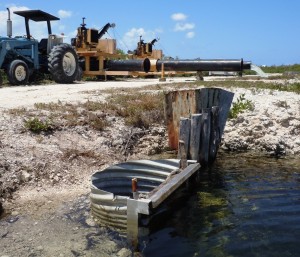
During the spring time low tides we are able to block off large sections of the swamp using a system of sluice gates and water is pumped into these areas in order to flood them. This is maintained for several days to allow the larvae to hatch. Following this the sluice gates are opened and the water drains out to sea taking large numbers of mosquito larvae with it and stranding the rest in the mud to die.
The canals also act as a passive means of control allowing tidal variations into and out of the swamp. They also aid drainage after heavy rainfall.
Biorational Mosquito Control products
Pesticides vary in their toxicity and in their potential ecological impact. Pest control materials that are relatively non-toxic to people with few environmental side effects are sometimes called “biorational” pesticides. These fit well into an integrated pest management strategy, which relies on monitoring for early detection of pests and emphasizes the use of selective products that provide control while preserving the ecological health of the farm and minimizing negative effects on beneficial insects that suppress pests. MRCU incorporates a number of these biorational products in their integrated mosquito control programme.

Bacillus thuringiensis subsp. israelensis (Bti) is a naturally occurring soil bacteria used as a microbial insecticide tocontrol the spread of vector-borne diseases, protect public health, and manage insect pest species. Bti was firstdiscovered in a stagnant pond in Israel in 1976 (Margalit and Dean 1985). Initial testing of Bti revealed acutetoxicity to mosquitoes (Goldberg and Margalit 1977) and black flies (Undeen and Nagel 1978). Further researchdemonstrated that Bti is nontoxic to humans, mammals, birds, beneficial insects, fish, plants, and most aquaticorganisms (EPA 1998 Bti EG2215 Factsheet). Bti an ideal pesticide with greatly reduced environmental impacts incomparison to man-made chemical insecticides. In addition, Bti is species specific, breaks down rapidly, limitednon-target impacts (de Barjac and Sutherland 1990), There are 26 Bti products in the United States with some ofthe following trade Names: Vectobac, Teknar, Aquabac, Bactimos, LarvX, etc.

Spinosad is natural product approved for use in organic agriculture by numerous national and international regulators including the US EPA. Spinosad has a good environmental profile and is an effective natural product for the integrated management of larval mosquitoes. It possesses a unique mode of action not shared by any other insecticide and is shown to be minimally disruptive to most non-target species tested. It is made by a soil bacterium named Saccharopolyspora spinosa and is a mixture of two chemicals called spinosyn A and spinosyn D.The genus Saccharopolyspora was discovered in 1985 in isolates from crushed sugar cane collected at an abandoned rum factory in the Caribbean Virgin islands. Evaluation of the bacterial actinomycete showed it to have powerful insecticidal properties. Spinosad has been registered for use in pesticides by the US Environmental Protection Agency (EPA) since 1997. MRCU has been using EPA approved spinosad based products since 2012. Spinosad is highly active against larvae of all mosquito species tested. The only spinosad based products currently available for mosquito control in the Caribbean region are sold under the trade name Natular. Natular products are the first larvicides evaluated as a Reduced Risk product by the EPA.Spinosad is highly active to mosquito larave, by both contact and ingestion. Spinosad affects the nervous system of insects that eat or come in contact with it, primarily targeting binding sites on nicotinic acetylcholine receptors of the insect nervous system and causing their muscles to flex uncontrollably. This ultimately leads to paralysis and death in 24-48 hours.

Methoprene is a growth regulator which prevents larvae by imitating the mosquitoes natural juvenile hormone. Because methoprene affects other insects but is safe for humans and mammals, it’s also formulated and sold for controlling a variety of other pests, from flies on cattle farms to fleas on dogs. Methoprene does not work by killing mosquito larvae directly; they will continue to live as larvae until they’re eaten by predators or die naturally but they will never turn into adult mosquitoes.
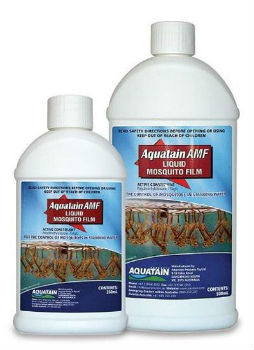
Aquatain AMF is a unique silicone-based liquid for mosquito control. The product has a purely physical action and does not contain any toxic chemicals. It spreads across the surface of standing water – even large water bodies – and forms a very thin film. As silicones have a very low surface tension, the film prevents pupae and larvae from attaching themselves at the surface while attempting to breathe, thereby causing them to drown.Aquatain AMF is approved for sale in 60 countries including Australia. In April 2015, the European Commission formally exempted the product from registration in the European Union due to its physical action. Aquatain AMF has been prequalified by the World Health Organization (WHO) for procurement by the UN and other international agencies and countries in tackling mosquito-borne diseases.
Biological ControL
There are a number of natural predators that feed on adult mosquitoes and larvae. Some of the more common predators are detailed below. MRCU has utilized mosquito fish (Gambusia sp) in its control operations. In the mid-1970’s these fish were seeded across all mangrove areas of the island by dropping them from helicopters. They are now established and play an important role in reducing mosquito numbers.
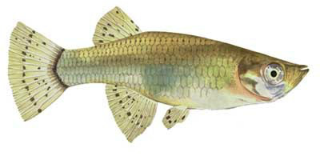
Goldfish, guppies, bass, bluegill and catfish prey on mosquito-larvae. But the most important fish predator, by far, are the Gambusia species, commonly known as the mosquito fish. This is probably the most effective predator of mosquito larvae and is used by many mosquito control agencies to augment their control efforts.

Many birds will eat mosquitoes. The more important among these are purple martins, swallows, waterfowl (geese, terns, ducks) and migratory songbirds. Bird predators usually eat both the adult and aquatic stages of mosquitoes.

Most adult frogs and tadpoles do not include mosquitoes as a large part of their diet. Tadpoles infrequently feed on mosquito larvae and instead generally feed on small, suspended particles of plant-related materials. However, mosquito larvae predation is known for three species of North American tadpoles – the spade foot toad, green tree frog and giant tree frog. While not a direct act of predation, tadpoles may compete with mosquito larvae for food.

Dragonflies are often referred to as “mosquito hawks.” Though they do eat mosquitoes, they do not eat enough mosquitoes to do much harm to wild populations. One feature that favors dragonflies as mosquito predators is that in the dragonflies’ aquatic stage, most of its food consists of mosquito larvae.
Damselflies
While damselflies are not as effective in controlling mosquitoes as dragonflies, their aquatic stage also consumes many mosquito larvae.

While bats eat mosquitoes, they are far more effective at locating, catching and eating insects other than mosquitoes.
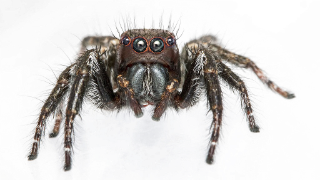
Spiders become mosquito predators when a mosquito inadvertently flies into a spider’s web where it is encased and eaten.

The red-eared slider turtle is generally thought to be the most voracious turtle that feeds on mosquito larvae.

Some mosquitoes prey on other mosquitoes. The most notable being the predatory mosquitoes in the genus Toxorhynchites. These mosquitoes provide a double benefit since the larvae are predacious on other mosquito larvae and the adults are not known to transmit disease.
Both adult and larval species of aquatic beetles will consume mosquito larvae and pupae. Two beetles that readily eat the aquatic stages of mosquitoes are the predaceous diving beetle and the water scavenger beetles. However, they will consume many types of aquatic insects other than mosquitoes.
Synthetic Pyrethroids
Pyrethroids are synthetic chemical insecticides widely used for controlling a variety of insects. Permethrin and Deltamethrin are the two synthetic pyrethroids commonly used by MRCU to kill adult mosquitoes.
Permethrin has been registered by the EPA since 1979. It is currently registered and sold in a number of products such as residential indoor and outdoor insect foggers and sprays, treated clothing, flea products for dogs, termite treatments, agricultural and livestock products, and mosquito abatement products. It is also regulated by the Food and Drug Administration as a treatment of head lice and scabies. Permethrin is the most widely used mosquito adulticide in the U.S. and is used to treat 9 to 10 million acres annually (out of 32-39 million acres treated with a mosquito adulticide). Permethrin’s widespread use can be attributed to its low cost, high effectiveness, low incidence of pest resistance, and broad labeling.
Most pyrethroid mosquito control products can be applied only by public health officials and trained personnel of mosquito control districts. MRCU applies pyrethroids as an ultra-low volume (ULV) spray from both trucks and aircraft. ULV sprayers dispense very fine aerosol droplets that stay aloft and kill adult mosquitoes on contact. Pyrethroids used in mosquito control are typically mixed with a synergist compound, such as piperonyl butoxide, which enhances the effectiveness of the active ingredient. The product is often diluted in water or oil and applied at rates less than 1/100th of a pound of active ingredient or less than 4 fluid ounces of mixed formulation per acre.
The United States Environmental Protection Agency (EPA) has conducted human health risk assessments for all labeled uses of pyrethroids. Based on the results of these assessments and any required label changes, pyrethroids can be used for public health mosquito control programs without posing unreasonable risks to human health when applied according to the label. At high exposure levels, such as those resulting from accidents or spills, pyrethroids can affect the nervous system.
When applied according to label directions, pyrethroids used in mosquito control programs do not pose unreasonable risks to wildlife or the environment. Pyrethroids are low in toxicity to mammals and are practically nontoxic to birds. However, pyrethroids are toxic to fish and to bees.
The EPA reevaluates all pyrethrins, pyrethroids and synergists through registration review. Registration review is our program for systematically reviewing all registered pesticides every 15 years to make sure that every pesticide can still perform its intended function without unreasonable adverse effects on human health or the environment.
As a result of the Food Quality Protection Act, EPA must consider the cumulative risks of pesticides that, like the pyrethroids and pyrethrins, share a common mechanism of toxicity. In November 2011, the EPA completed a cumulative risk assessment for the pyrethroids/pyrethrins and identified no cumulative risks of concern. This assessment is available from Regulations.gov, docket EPA-HQ-OPP-2011-0746.
The Environmental Protection Agency (EPA) evaluates and registers (licenses) pesticides to ensure they can be used safely. These pesticides include products used in the mosquito control programs which states and communities have established. To evaluate any pesticide, EPA assesses a wide variety of tests to determine whether a pesticide has the potential to cause adverse effects on humans, wildlife, fish and plants, including endangered species and non-target organisms.
mosquito officials select control measures that best suit local conditions Officials responsible for mosquito control programs make decisions to use pesticides based on an evaluation of the risks to the general public from diseases transmitted by mosquitoes or on an evaluation of the nuisance level that communities can tolerate from a mosquito infestation. Based on surveillance and monitoring, mosquito control officials select specific pesticides and other control measures that best suit local conditions in order to achieve effective control of mosquitoes with the least impact on human health and the environment. It is especially important to conduct effective mosquito prevention programs by eliminating breeding habitats or applying pesticides to control the early life stages of the mosquito. Prevention programs, such as elimination of any standing water that could serve as a breeding site, help reduce the adult mosquito population and the need to apply other pesticides for adult mosquito control. Since no pesticide can be considered 100% safe, pesticide applicators and the general public should always exercise care and follow specified safety precautions during use to reduce risks.
Malathion
Malathion is an insecticide commonly used in mosquito control programs.Malathion is an organophosphate (OP) insecticide that has been registered for use in the United States since 1956. It is used in agriculture, residential gardens, public recreation areas, and in public health pest control programs. When applied in accordance with the rate of application and safety precautions specified on the label, malathion can be used to kill mosquitoes without posing unreasonable risks to human health or the environment.
Malathion is an adulticide, used to kill adult mosquitoes. MRCU applies malathion by truck-mounted and aircraft-mounted sprayers.Malathion is applied as an ultra-low volume (ULV) spray. ULV sprayers dispense very fine aerosol droplets that stay aloft and kill mosquitoes on contact. ULV applications involve small quantities of pesticide active ingredient in relation to the size of the area treated. For mosquito control, malathion is applied at a maximum rate of 0.23 pounds (or about two and one-half fluid ounces) of active ingredient per acre, which minimizes exposure and risks to people and the environment.
Malathion can be used for public health mosquito control programs without posing unreasonable risks to the general population when applied according to the label. The EPA has estimated the exposure and risks to both adults and children posed by ULV aerial and ground applications of malathion. Because of the very small amount of active ingredient released per acre of ground, the estimates found that for all scenarios considered, exposures were hundreds or even thousands of times below an amount that might pose a health concern. These estimates assumed several spraying events over a period of weeks, and also assumed that a toddler would ingest some soil and grass in addition to skin and inhalation exposure.
However, at high doses, malathion like other organophosphates, can overstimulate the nervous system causing nausea, dizziness, or confusion. Severe high-dose poisoning with any organophosphate can cause convulsions, respiratory paralysis and death.




